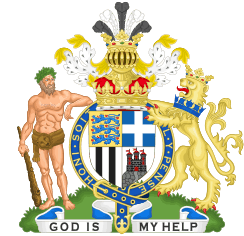HMS Magpie (U82)
 Magpie in the Atlantic | |
| History | |
|---|---|
| Name: | HMS Magpie |
| Namesake: | Magpie |
| Builder: | John I. Thornycroft & Company |
| Launched: | 1943 |
| Commissioned: | 30 August 1943 |
| Reclassified: | As a frigate in 1947 |
| Identification: | pennant number U82 |
| Fate: | Broken up 1959 |
| General characteristics | |
| Class and type: | Modified Black Swan-class sloop |
| Displacement: | 1,350 tons |
| Length: | 299 ft 6 in (91.29 m) |
| Beam: | 38 ft 6 in (11.73 m) |
| Draught: | 11 ft (3.4 m) |
| Propulsion: |
|
| Speed: | 20 knots (37 km/h) |
| Range: | 7,500 nmi (13,900 km) at 12 kn (22 km/h) |
| Complement: | 192 |
| Armament: |
|
| Service record | |
| Part of: | 7th Frigate Squadron (1955-1958) |
| Commanders: | Prince Philip, Duke of Edinburgh (1950) |
| Operations: |
|
| Victories: | U-592, U-238, U-734 (1944) |
HMS Magpie, pennant number U82, was a Royal Navy Modified Black Swan-class sloop launched in 1943 and broken up in 1959. She was the seventh Royal Navy ship to bear the name. The ship was the only vessel commanded by Prince Philip, Duke of Edinburgh, who took command on 2 September 1950.
Service history
Commissioned on 30 August 1943, during October–November 1943 Magpie was part of the 2nd Support Group in the North Atlantic.
On 31 January 1944 on North Atlantic convoy escort duties, Magpie along with the sloops Starling and Wild Goose intercepted and sank, by depth charges, German submarine U-592 which was on its way to France for repairs.
The following month saw Magpie involved in destroying U-238 and U-734. After serving as an escort during the D-Day amphibious Allied landings in Normandy, Magpie served in British coastal waters, operating from Greenock as an escort to the Gibraltar convoys.
Along with others in the Black Swan class she was officially reclassified as a frigate in 1947, also receiving a new pennant number 'F82. Magpie did duty in Trieste following riots there over the city’s future, which was contended between Italy and Yugoslavia. At this time she was based in Malta, as part of the 3rd Frigate Flotilla. This Flotilla took part in patrols preventing illegal immigrants following the formation of Israel. She returned to Portsmouth in 1954 where was placed in reserve.[1]
She was commanded by Lieutenant-Commander HRH The Duke of Edinburgh from 2 September 1950 until 1952, in the Mediterranean. In 1953 she took part in the Fleet Review to celebrate the Coronation of Queen Elizabeth II.[2] On 3 March 1955 Magpie left Portsmouth to steam to the 7th Frigate Squadron at Simonstown, South Africa. Due to be relieved at the Cape Station by her sister ship Sparrow, boiler problems meant the crew were changed. Magpie’s crew returned to the UK in Sparrow. In 1958 Magpie had her tour of duty at the Cape Station finally completed; she sailed back for the UK for paying off, and was broken up by Hughes Bolckow, Blyth, Northumberland on 12 July 1959.
HMS Magpie stood in for the moving shots of HMS Amethyst in the film Yangtse Incident in 1957.[3]
References
- ↑ Marriott, Leo (1983). Royal Navy Frigates 1945-1983. Ian Allen Ltd. ISBN 978-0-7110-1322-3 p.15
- ↑ Souvenir Programme, Coronation Review of the Fleet, Spithead, 15th June 1953, HMSO, Gale and Polden
- ↑ "The Yangtse Incident:the story of HMS Amethyst". British Lion Films. British Lion Holdings Ltd. Retrieved 27 April 2016.
Publications
- Colledge, J. J.; Warlow, Ben (2006) [1969]. Ships of the Royal Navy: The Complete Record of all Fighting Ships of the Royal Navy (Rev. ed.). London: Chatham Publishing. ISBN 978-1-86176-281-8. OCLC 67375475.
- Hague, Arnold (1993). Sloops: A History of the 71 Sloops Built in Britain and Australia for the British, Australian and Indian Navies 1926–1946. Kendal, England: World Ship Society. ISBN 0-905617-67-3.
